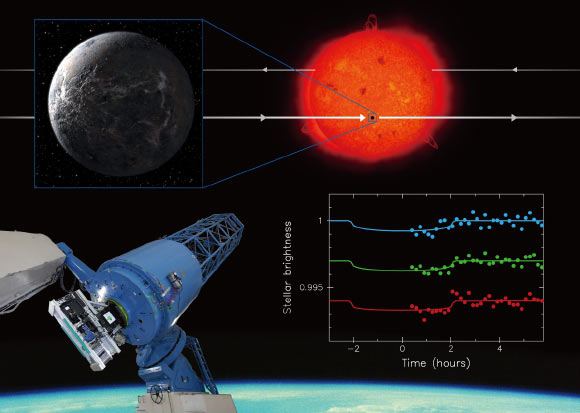A team of astronomers in Japan has conducted the first ground-based transit observation of K2-3d, a super-Earth within the habitable zone around a bright M-dwarf star, using the multi-band imager MuSCAT on the Okayama Astrophysical Observatory 1.88-m telescope.
A transit is a phenomenon in which a planet passes in front of its host star, blocking a small portion of the starlight.
While transits have previously been observed for thousands of other exoplanets, K2-3d is important because there is a possibility that it might support life.
This planet was discovered in 2015 in orbit around K2-3, a cool red M-dwarf about half the size and mass of our own Sun.
Also known as EPIC 201367065, the star lies at a distance of 147 light-years and hosts two other super-Earth exoplanets, K2-3b and c.
“Given the brightness of the host star, K2-3d is currently one of the best targets for spectroscopic characterizations of potentially habitable planets,” the astronomers said.

Akihiko Fukui et al report the first ground-based transit observation of K2-3d, a super-Earth supposedly within the habitable zone around a bright M-dwarf host star. Image credit: NAOJ.
K2-3d is about 1.5 times more massive than Earth and has an Earth Similarity Index of 0.80.
“This planet has an orbital period of 44.6 days, which corresponds to a semi-major axis of 0.208 AU, where the planet receives 1.5 times the light intensity of Earth,” the authors said.
“This means that the planet is probably located at the inner edge of or well within the habitable zone around K2-3.”
“The composition of K2-3d could be dominated by rock, given its radius of 1.5 Earth-radii, which is on the boundary between rocky and volatile-rich planets for close-in planets,” they added.
“There is a possibility that liquid water could exist on its surface.”
The team’s results were published in the Nov. 21, 2016 issue of the Astronomical Journal (arXiv.org preprint).
_____
Akihiko Fukui et al. 2016. Ground-based Transit Observation of the Habitable-zone Super-Earth K2-3d. AJ 152, 171; doi: 10.3847/0004-6256/152/6/171








